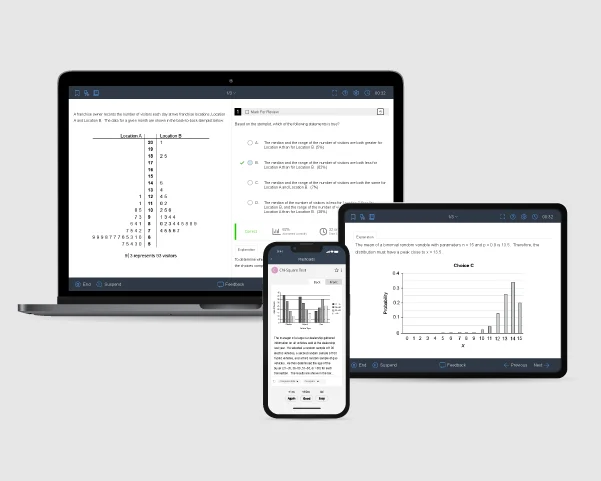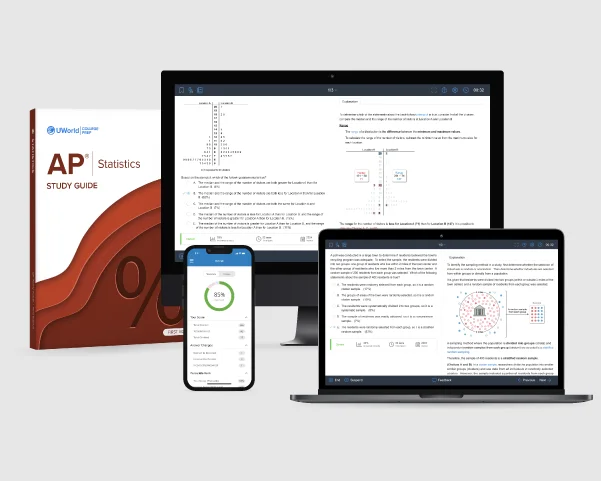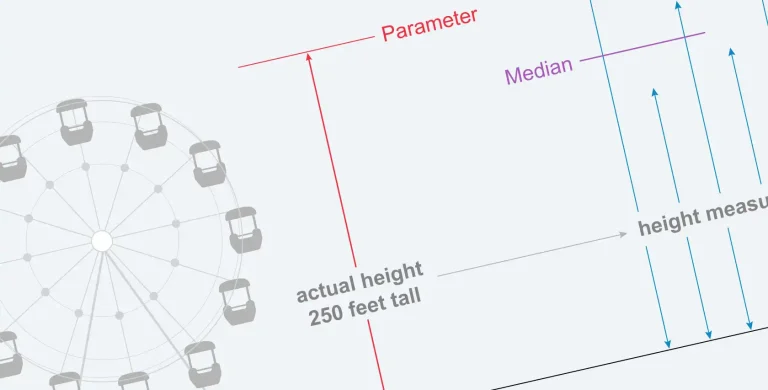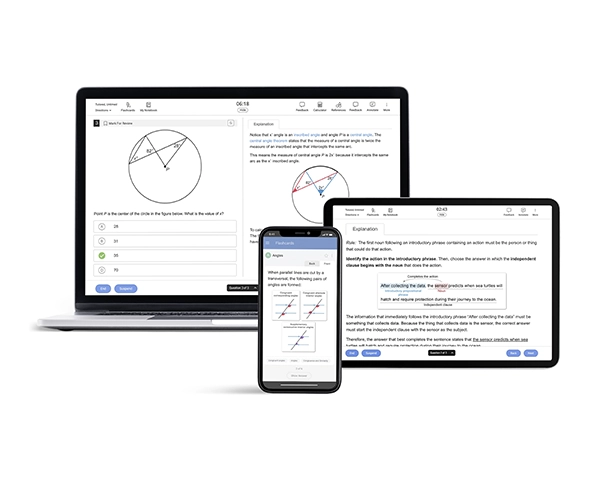You will learn about the types of questions, their topics and the time allotted to answer the sections.
What Is the Exam Format of AP Statistics?
The exam is divided into two sections, Section I and Section II, with each section lasting for one hour 30 minutes. The AP Statistics Exam has consistent question types and weighting every year, so you know what to expect on exam day. Let's go through the table below to see what the AP Statistics exam format looks like:
| Section | Questions | Time | Score Weight | |
|---|---|---|---|---|
| Section I | Multiple-Choice Questions (MCQs) | 40 | 1 hour 30 mins | 50% |
| Section II | Free-Response Questions (FRQs) | 6 | 1 hour 30 mins | 50% |
The overall score for the AP Statistics exam is calculated on a scale from 1 to 5. A score of 3 or higher is considered for advanced placement and college credit. However, every college has a specific set of requirements regarding AP credit. Be sure to check with your college to learn about their AP credit policy and regulations.
Coming back to the AP Statistics exam structure, let's discuss each section in detail.

Section I
The first section consists of 40 multiple-choice questions. The total time allotted for this section is 1 hr 30 mins, which gives you roughly about two minutes to answer each question. You are allowed to use a graphing calculator for this section.
Section II
This section has two parts, Part A consists of five FRQs, and Part B includes one question, which is an investigative task. You will need to use a graphing calculator to approach this section. The table below breaks down Section II for an easy read:
| Section II | Part A | Part B |
|---|---|---|
| Total Time Allotted | 1 hr 30 mins | 1 hr 30 mins |
| Calculator Usage | Permitted | Permitted |
| No. of Questions | 5 | 1 |
| Question Types | 1. One multipart question with a primary focus on collecting data | One investigative task that assesses multiple skill categories and content areas, focusing on applying skills and content in new contexts or non-routine ways |
| 2. One multipart question with a primary focus on exploring data | ||
| 3. One multipart question with a primary focus on probability and sampling distributions | ||
| 4. One question with a primary focus on inference | ||
| 5. One question that combines two or more skill categories |
Part A contains five short-answer questions. Each of these questions can include several parts. For Part A, it is ideal to answer each question in about 12 minutes each and keep about 30 minutes to complete the investigative task in Part B.
Part B contains the most in-depth question on the test, and you should answer it in about 30 minutes. It will have multiple parts that you must answer and will require a variety of statistics skills. You will also need to explain your answers to demonstrate your statistical knowledge. Your answer will be graded holistically, so make sure to show all the steps you took to deduce your answer. Check out the AP Statistics score guide to know how your free-response answers are graded.
Types of Questions in AP Statistics Exam
As mentioned earlier, each of the two sections in the AP Statistics exam carries 50% weight of the total exam score. Now let us discuss each section of the exam, including the units they cover from the AP statistics course and the weight each of these units carries. Although the College Board® does not specify the unit weights for the Free-Response section, we can find out the unit weights for the multiple-choice questions. We will also address a few tips on approaching these with ease.
Section I: Multiple Choice Questions
As you may already know, the MCQ section includes 40 questions, each with five predetermined answer choices. For each question, you must select the correct answer from five options. These answer options are frequently similar, leading the student to believe that there could be more than one correct answer. Take your time to answer each question by taking a hint from the answer choices and pick the option that matches the derived answer.
The nine units that you will study during your AP Stats course will carry varying weights in the MCQ section. Let us look at these units and their respective weights in Section I.
| Unit | Weight in MCQ Section |
|---|---|
| Unit 1: Exploring One-Variable Data | 15–23% |
| Unit 2: Exploring Two-Variable Data | 5–7% |
| Unit 3: Collecting Data | 12–15% |
| Unit 4: Probability, Random Variables, and Probability Distributions | 10–20% |
| Unit 5: Sampling Distributions | 7–12% |
| Unit 6: Inference for Categorical Data: Proportions | 12–15% |
| Unit 7: Inference for Quantitative Data: Means | 10–18% |
| Unit 8: Inference for Categorical Data: Chi-Square | 2–5% |
| Unit 9: Inference for Quantitative Data: Slopes | 2–5% |
Remember that the units carrying higher weights will reappear more often in the MCQ section. For example, you will most likely get more questions from Unit 3 than from other units, like Unit 8. Keeping this in mind will help you focus on these sections, and you can distribute your study plan based on the unit weights. You can check out our guide on AP Statistics Multiple-Choice Questions to familiarize yourself with tips and tricks!
Section II: Free-Response Questions
The free-response questions in Section II, require you to demonstrate the step-by-step processes you employed to solve a problem and derive the answers. As we have already discussed, this section assesses your analytical and problem-solving skills. It is graded manually by AP instructors and college teachers called AP Readers. Both parts A and B in this section employ holistic marking, where you will be graded on how you approached the problem and derived the correct answer.
While you focus on learning how to answer AP Stats free-response questions, remember to take a few AP Statistics practice tests. It helps you boost your time management skills and familiarizes you with the question topics and patterns.
AP Statistics Exam - Digital Mode
The AP Statistics exam will be administered in a hybrid digital format. You'll answer multiple-choice questions and view the free-response questions in the Bluebook app, but you'll write your free-response answers by hand in the provided paper exam booklet.

References
- (2024). AP Statistics Exam – AP Central | College Board. (n.d.). Retrieved on December 19, 2024, from https://apcentral.collegeboard.org/courses/ap-statistics/exam
- (2020). AP Statistics COURSE AND EXAM DESCRIPTION. (n.d) Retrieved on December 19, 2024, from https://apcentral.collegeboard.org/media/pdf/ap-statistics-course-and-exam-description.pdf
Read More About the AP Statistics Exam
AP Statistics Course and Exam Description
Save time by reading our summarized AP Statistics Course and Exam Description, which provides you with an in-depth understanding of the topics covered in your Stats course.
Are you curious about how the AP Statistics Exam is graded? Continue reading to learn everything about AP Stats exam scoring and use our calculator to estimate your score!
AP Statistics Study Guide & Materials
Want to score a 5 and get into prestigious schools? Check out our AP Statistics study guide written by industry experts—including crucial review tips to make exam prep effortless.
Best AP Statistics Study Guide Comparison
Compare the best AP Statistics study guides! See how Kaplan, Barron's, and Princeton Review stack up against UWorld for comprehensive exam prep.
Best AP Statistics Prep Course Review
Searching for top AP Statistics prep courses? Read this review to compare the best courses and choose the perfect one for your success.
How to Self-Study for AP Statistics
Self-studying for AP Statistics? Use this proven step-by-step guide to master concepts, stay organized, and achieve top exam scores.

